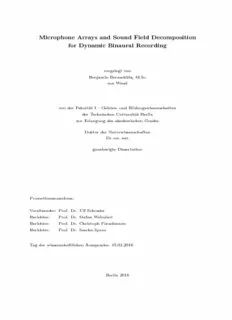
Microphone Arrays and Sound Field Decomposition for Dynamic Binaural Recording PDF
Preview Microphone Arrays and Sound Field Decomposition for Dynamic Binaural Recording
Microphone Arrays and Sound Field Decomposition for Dynamic Binaural Recording vorgelegtvon BenjaminBernschütz,M.Sc. ausWesel vonderFakultätI–Geistes-undBildungswissenschaften derTechnischenUniversitätBerlin zurErlangungdesakademischenGrades DoktorderNaturwissenschaften Dr.rer.nat. genehmigteDissertation Promotionsausschuss: Vorsitzender: Prof. Dr. UlfSchrader Berichter: Prof. Dr. StefanWeinzierl Berichter: Prof. Dr. ChristophPörschmann Berichter: Prof. Dr. SaschaSpors TagderwissenschaftlichenAussprache: 15.02.2016 Berlin2016 Microphone Arrays and Sound Field Decomposition for Dynamic Binaural Recording BenjaminBernschütz DoctoralDissertation Researchandwritingfrom2009–2015,Publishedin2016 TechnicalUniversityofBerlin–AudioCommunicationGroup TechnologyArtsSciencesTHKöln–InstituteofCommunicationsSystems This dissertation was written at Technical University of Berlin, Faculty I – Audio CommunicationGroupundersupervisionofProf.Dr.StefanWeinzierl. Funded by the German Federal Ministry of Education and Research, support codes: 1707X08and17009X11,grantedtoTHKöln,Faculty07–InstituteofCommunications Systems,Prof.Dr.Pörschmann. LicensedunderaCreativeCommonsAttributionCC-BY4.0InternationalLicense. WrittenwithaLATEXtypesettingsystemusingTeXLiveandTexmaker. ReferencesmanagedwithPapersforMACandBibTeX. VectordrawingsmadewithTikZandOmniGraffle. Pixelgraphics/photoseditedwithPixelmator. DiagramsplottedwithMATLAB⃝R. CoverpicturetakenbyPhilippStadeatWDRKöln. Tomybelovedparents MonikaBernschütz-Hörnchen† andWalterBernschütz†. f Acknowledgements I thank my doctoral adviser Professor Dr. Stefan Weinzierl for his fantastic support, fruitfuldiscussionsandinvaluableadvises. Iamimpressedbythebreadthofhisknowl- edge and his extraordinary sense of accuracy. It is a great honor and privilege to be yourdoctoralstudent. IthankProfessorDr.ChristophPörschmann,anincrediblevisionaryandrazor-sharp mind, who made this work possible and had the initial ideas. I had the great chance and honor to work with him for six years in an outstanding working environment. Professor Pörschmann has supported this work and myself in so many different ways. Ithankyouverymuch,onaprofessionalaswellasonapersonallevel. IthankProfessorDr.SaschaSpors, oneoftheleadingexpertsinspatialaudiosignal theory, for his steady support and guidance since the time I was writing my master thesisunderhissupervision. Itisagreathonortohaveyouassupporterandreviewer formydoctoralthesisnow. ThisworkwasfundedbytheBundesministeriumfürBildungundForschung(BMBF) in Germany in the scope of two different research projects. Thanks for the great supportandtheopportunities. Many thanks go to (in alphabetic order) Johannes Arend, Antje Goldenberg, Gary Grutzek, Dominic Hemmer, Ulla Jantzen, Philipp Stade and Arnau Vázquez-Giner, my dear colleagues and friends at the Institute of Communications Systems at TH Köln for the incredibly great times we had and for the steady professional exchange, supportandinspiration. VeryspecialthanksfordirectcontributionstoArnauVázquez-Ginerwhocollaborated with me in the research projects. He was responsible for implementing the listening experimentsoftwareandsettingupthelisteningexperimentsthatappearinthiswork. VeryspecialthankstoPhilippStadeandMaxRühlwhoperformedtheacousticmea- surements at the WDR broadcast studios with me at any time of the day. This was rock’n’roll. Another very special thanks to Johannes Arend for intense support with thelisteningexperiments. Whatwouldsciencebewithoutthatterrificscientific-lookinghardware? Specialthanks fortransformingmycrazyideas,professionallysketchedonawrinkledtissue,intosolid andfunctionalhardwaretothegreatguysfromthemechanicworkshopoftheInstitute ofCommunicationsSystemsatTHKöln,AaronFinkenthei,MichaelSöntgenrathand GerdMies. Yourworkisfantastic. Thanks to the large amount of people who participated in the listening experiments. Particularly many thanks to the group of expert listeners who spent a lot of time vi and effort. You are all really great. Sorry, I cannot mention all of your names here. Also many thanks to several bachelor and master students who directly or indirectly supportedthiswork. ThankstotheWDRradiobroadcaststudiosinCologneandespeciallyMarkusHaßler andBenediktBitzenhoferfortheirsteadysupport,andforenablingtheacousticmea- surements. Thanks to IOSONO/BARCO Audio Technologies for providing the fantasic binaural renderer that was used for the listening experiments. Very special thanks to Lutz Altmann, who modified the rendering software and remote protocol according to our requirements. Thanks for many fruitful discussions, scientific exchange, and a lot of joyful evenings at various conferences and meetings to my dear colleagues from Technical University of Berlin and University of Rostock (in alphabetic order) Dr. Jens Ahrens, Fabian Brinkmann,VeraErbes,MatthiasGeier,MichaelHorn,Dr.AlexanderLindau,Frank Schultz,andDr.HagenWierstorf. Youcannotwriteadoctoralthesiswithoutmassivesupportfromyourfamily. Ideeply thank my parents Monika Bernschütz-Hörnchen and Walter Bernschütz, who both passedawayjustbeforeIdefendedandpublishedmywork. Youdidnotknowit,but thisworkwasdedicatedtobothofyoufromthebeginning. Attheendyoucouldnot be here with me to celebrate the graduation. I miss you and thank you so much for everything. ManyspecialthanksgotomydearrelativesintheUSA,toDr.HansGeorgRitterat BerkeleyLab,forproofreadingmywork. ThankstomysisterDr.RebeccaSchorm-BernschützwithherhusbandDr.Alexander SchormandmybrotherBastianBernschützfortheirsupportinmanydifferentways. I alsothankmysecondfamilyUrsulaandPeterSpang,aswellasDr.UlrikeandCarsten Weinholdfortheirkindsupport. I deeply thank my partner Dr. Astrid Spang for standing by my side during all this time,forherlove,patience,andfull-timesupport. ManythankstooursonArminwho enlightenedmydaysduringthelastfewweeksofthiswork. BenjaminBernschütz, December2015 vii Abstract Thisthesisdiscussesafield-relatedrecordingtechniquebasedonmicrophonearraysand orthogonalsoundfielddecompositionthatdeliversasuitabledescriptionfordynamic binauralreproduction. Dynamic binaural reproduction refers to a mostly headphone-based reproduction methodthatallowsforpresentinglocalizablevirtualsourcesandaccountsforthehead movementsoftherecipientinordertodecouplethemfromthespatialorientationofthe virtual auditory scene. Increased source localization and externalization stability can be regarded as primary advantages compared to classic static binaural reproduction. Spatiallystationaryordynamicvirtualsoundsourcescanbepresentedthatmaintain theirspatialpositionsormoveinrelationtoafixedexternalworldcoordinatesystem, whichisindependentfromtherecipient’sheadmovements. Dynamic binaural reproduction requires either object-based audio production or spe- cific field-related recording techniques. The focus of this thesis lies on the latter. Us- ing microphone arrays paired with orthogonal sound field decomposition appears to be a particularly promising approach for field-related dynamic binaural recording. It is based on an elegant, closed-form mathematical solution and allows accounting for head-tracking in all rotational degrees-of-freedom during the playback of a recorded auditoryscene. Theoretically,eventranslationoftherecipientcanbeconsidered. The method inherently comprises individualization capabilities by employing individual head-related transfer functions (HRTFs) and allows for point-to-multipoint distribu- tion. Duetotheclosemathematicalrelationshipwithhigher-orderAmbisonics(HOA), therespectiveformatsandcodecscanbeusedforstorageanddistributionoftheaudio data. The theoretical mathematical approach under ideal physical conditions is discussed andaclosed-formsolutionisderived. Duetoconstraintsintechnicalsystems,suchas discretespatialsamplingornoiseinthesignalpathsforinstance,idealconditionscan- notbemaintainedinpractice. Themajorconstraintsarepointedoutandtheirspecific impact is analyzed and assessed. Various approaches for improving the transmission characteristics of the system are proposed and evaluated. The perceptual properties underdedicatedtechnicalconstraintsandrealisticconditionsareassessedinlistening experiments. Optimal technical parameters for the system are also determined. It turns out that an array-based system for dynamic binaural recording with satisfying perceptual properties can be realized within reasonable technological and economical limits. viii AbstractinGerman Die vorliegende Dissertationsschrift behandelt ein feldbezogenes räumliches Audioauf- nahmeverfahren,dasaufMikrofonarraysundorthogonalerSchallfeldzerlegungberuht undeinegeeigneteBeschreibungfürdynamischebinauraleWiedergabeliefert. DynamischebinauraleWiedergabebezeichneteinmeistkopfhörerbasiertesräumliches Audiowiedergabeverfahren zur Darbietung lokalisierbarer virtueller Schallquellen, das dieKopfbewegungdesRezipientenberücksichtigt,umsievonderräumlichenOrientie- rungderwiedergegebenvirtuellenauditorischenSzenezuentkoppeln.Diewesentlichen VorteilegegenüberstatischerbinauralerWiedergabebestehenineinerverbessertenLo- kalisationundExternalisierungdervirtuellenQuellen,sowiederMöglichkeit,statische oder dynamische virtuelle Quellen wiederzugeben, die unabhängig von der Kopfbe- wegung des Rezipienten ortsfest verbleiben oder sich in Bezug zu einem statischen weltbezogenenKoordinatensystembewegen. Dynamische binaurale Wiedergabe setzt entweder objektbasierte Audioproduktion oderspezifischefeldbezogeneAufnahmeverfahrenvoraus.LetztereliegenimFokusdie- ser Arbeit. Der Einsatz von Mikrofonarrays in Kombination mit orthogonaler Schall- feldzerlegungstellthierzueinenvielversprechendenLösungsansatzdar.DasVerfahren beruht auf einer eleganten mathematisch geschlossenen Lösung. Kopfbewegungen des Rezipienten können in allen rotatorischen Freiheitsgraden berücksichtigt werden. In derTheorielassensichauchtranslatorischeFreiheitsgradeeinbeziehen.DurchEinsatz individuellerkopfbezogenerÜbertragungsfunktionen(HRTFs)kanndieWiedergabein- dividualisiertwerden.DasVerfahreneignetsichfürPunkt-zu-MehrpunktÜbertragung. AufgrundengermathematischerVerwandtschaftzumhigher-orderAmbisonics(HOA) Verfahren,lassensichdiedorteingesetztenFormateundCodecszurSpeicherungund ÜbertragungderAudiodatennutzen. UnterAnnahmeidealerphysikalischerBedingungenwirdzunächstdertheoretischeAn- satz diskutiert und eine mathematisch geschlossene Lösung abgeleitet. Aufgrund ver- schiedenerEinschränkungenintechnischenSystemen,wiebeispielsweiseraumdiskrete AbtastungoderRauschenindenSignalwegen,sindinderPraxisallerdingskeineidea- len Bedingungen erzielbar. Die wichtigsten Einschränkungen werden aufgezeigt und ihrjeweiligerEinflussaufdasSystemverhaltenuntersucht.VerschiedeneMethodenzur Verbesserung der Übertragungseigenschaften werden diskutiert. In Hörversuchen wer- den perzeptive Eigenschaften des Systems im Hinblick auf spezifische technische Ein- schränkungensowierealistischeBedingungenevaluiert.FernerwerdenoptimaleSystem- parameterermittelt.Eszeigtsich,dassarraybasierteSystemefürdiefeldbezogenedy- namische Binauralaufnahme mit guten perzeptiven Eigenschaften unter vertretbarem technischenundwirtschaftlichenAufwandrealisierbarsind. ix x
Description: